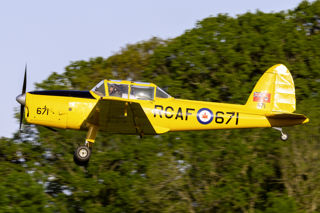
De Havilland Canada Chipmunk
The de Havilland Canada DHC-1 Chipmunk is a tandem configuration primary aircraft trainer developed to be a replace the famous Tiger Moth. Almost 1,300 were built for the RAF, RCAF and Portuguese Air Forces. The Chipmunk conducted its first flight in 1946 and entered production in 1947. A number of Chipmunks have found their way in to civilian service where they have been modified to suit their owners needs. This has included turboprop engines, bigger wings, bigger cockpits and wingtip fuel tanks. The Portuguese Air Force are still operating the Chipmunk as a basic trainer 70 years after entering service.
The Chipmunk entered service with the RCAF as a basic trainer in 1948 and eventually 113 aircraft served with the Canadian military before being retired in 1972. In RAF service the type provided primary training and in addition, eight aircraft were diverted to 114 Squadron in Cyprus to conduct security patrols whilst other Chipmunks were based at RAF Gatow where they were used for covert surveillance over Soviet controlled areas of Berlin. The Chipmunk has trained Royals, the late Prince Philip conducted his first flight in one and a bright red Chipmunk was used to train HM King Charles III to fly, this aircraft is now in civilian hands and has been preserved in its Royal scheme. A pair of Chipmunks are still in service with the RAF who use them for training pilots that join the Battle of Britain Memorial Flight.
The Shuttleworth Collection will this year be providing their Chipmunk for static display at this year’s Air Tattoo. The aircraft is painted in the scheme carried by RCAF Chipmunks whilst in service and will form part of our RCAF 100th anniversary celebrations.
Photo Credit: RIAT Volunteer
On display
| Role | Friday | Saturday | Sunday |
|---|---|---|---|
| Static | Yes | Yes | Yes |